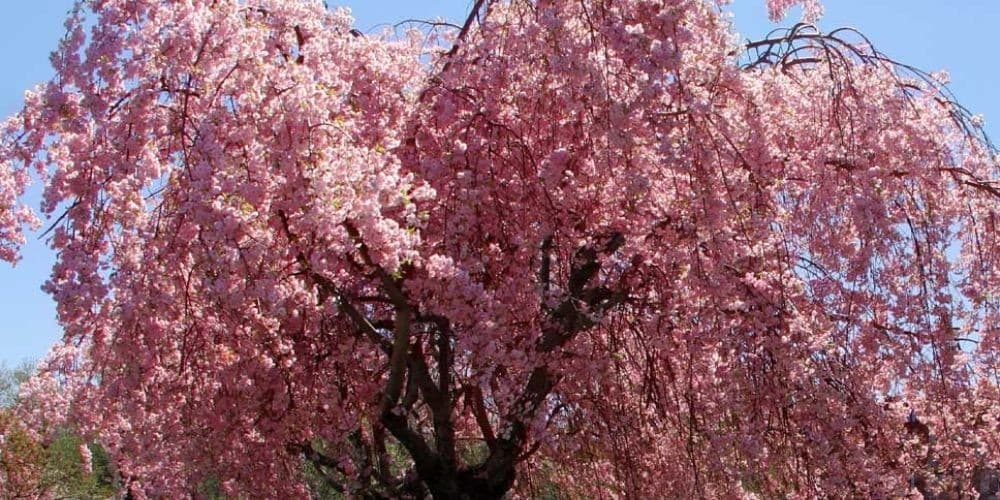The Things You Should Know About Pink Weeping Cherry Tree

18 Dec 23
The Weeping Cherry Tree, also known as the Higan Cherry, is a type of ornamental cherry tree prized for its delicate, drooping branches and beautiful pink or white flowers that bloom in the spring. The tree has a unique, graceful form and is often used as a specimen plant in landscaping.
The branches are long and flexible, giving them a distinctive appearance. The blooms are typically short-lived, lasting only a few days, but the tree is a popular sight during cherry blossom season in many parts of the world. Weeping cherry trees are often grown in parks and gardens and are also popular as street trees.
Origin of Weeping Cherry Tree
The origin of the Tree is Japan. It is a cultivar of the Somei-Yoshino cherry (Prunus yedoensis), a hybrid species developed in the Tokyo area in the late 19th century. The Somei-Yoshino cherry is a popular ornamental cherry in Japan and is widely planted in parks, temples, and streets.
The Weeping Yoshino Cherry Tree is believed to have been derived from this species and was first cultivated in Japan for its ornamental value. Over time, the tree became popular in other parts of the world, including Europe and North America, where it is now widely cultivated as an ornamental plant.
How to Grow Weeping Cherry Tree
Growing is relatively easy and can be a beautiful addition to any landscape. Here are some tips for developing a healthy and attractive Tree:
- Choose the right location: The trees prefer full sun to partial shade and well-drained soil. They need to be more tolerant of heavy, wet soils.
- Plant at the right time: The best time to plant a Weeping Yoshino Cherry Tree is in the spring when the soil is warmer and can provide the roots with ample moisture.
- Prepare the soil: Work compost or other organic matter into the ground to improve its structure and fertility before planting.
- Plant the tree properly: Dig a hole slightly wider and deeper than the tree's root ball. Place the tree in the hole, so the root ball is level with the surrounding soil. Backfill the hole with soil and water the tree well.
- Water regularly: Trees need regular watering, especially during the first growing season. Water the tree deeply once a week or more often if the weather is hot and dry.
- Fertilize: You can feed your Pink Weeping Cherry Tree with a slow-release fertilizer in the spring after the tree has started to grow.
- Prune judiciously: Pruning can help maintain the tree's shape and encourage healthy growth, but it's important to avoid over-prune or pruning at the wrong time. It's best to prune in late winter or early spring before the tree starts to put out new growth.
A Weeping Yoshino Cherry Tree can grow into a beautiful and long-lived landscape specimen with proper care.
Taking Care for Weeping Cherry Tree
Caring for a Tree is relatively simple. Here are some tips for maintaining a healthy and attractive tree:
Watering:
The trees need regular watering, especially during dry periods. Water the tree deeply, especially during the first growing season.
Soil:
The tree prefers well-drained soil and does not tolerate heavy, wet soils. If your soil is rich or poorly drained, consider amending it with compost or other organic matter to improve its structure.
Fertilization:
Dwarf Weeping cherry trees benefit from regular fertilization, especially in the spring when new growth begins. A slow-release fertilizer can apply to the soil around the tree to provide the necessary nutrients for growth.
Pruning:
Pruning is not necessary for the tree, but if you want to maintain its shape or control its size, it's best to prune in late winter or early spring before the tree starts to put out new growth.
Protection from winter weather:
The trees are hardy and can tolerate cold weather, but young trees may need protection from harsh winter winds and heavy snow. You can wrap the tree trunk with burlap or other protective material to keep it safe during winter.
Pest and disease control:
The trees are relatively disease-resistant but can be susceptible to pests like aphids, scale insects, and caterpillars. Regularly inspecting the tree and using appropriate control measures, if necessary, can help keep it healthy.
By following these tips, you can help ensure that your tree grows strong, healthy, and beautiful for many years.
Problems of Weeping Cherry Tree
Like all plants, they can sometimes experience problems affecting their health and appearance. Some of the most common issues include:
- The trees can be susceptible to pests like aphids, scale insects, and caterpillars, which can feed on the leaves, stems, and flowers.
- The trees can be affected by diseases like powdery mildew, leaf spot, and canker, which can cause discoloration, defoliation, and stunted growth.
- Young Trees can be vulnerable to winter damage from cold temperatures, harsh winds, and heavy snow.
- The trees need regular watering, but they can also suffer from waterlogged soil, leading to root rot and other problems.
- The tree prefers well-drained soil and can suffer if the soil is heavy, poorly drained, or lacks the necessary nutrients.
FAQs
- How to prune a weeping cherry tree?
Pruning a pink weeping cherry tree is important to maintain its shape and health and promote new growth. Remember to make clean, sharp cuts, and always avoid leaving stubs, as they can attract disease and insects. By following this, you can keep your tree healthy and beautiful.
- How to trim a weeping cherry tree?
The trees are prized for their graceful appearance and delicate, drooping branches. To maintain the desired form of the tree, it's important to perform regular pruning. Remember, the goal of pruning is to keep the tree's natural shape and promote healthy growth. Be patient, as it may take several seasons of pruning to achieve the desired form of your tree.

